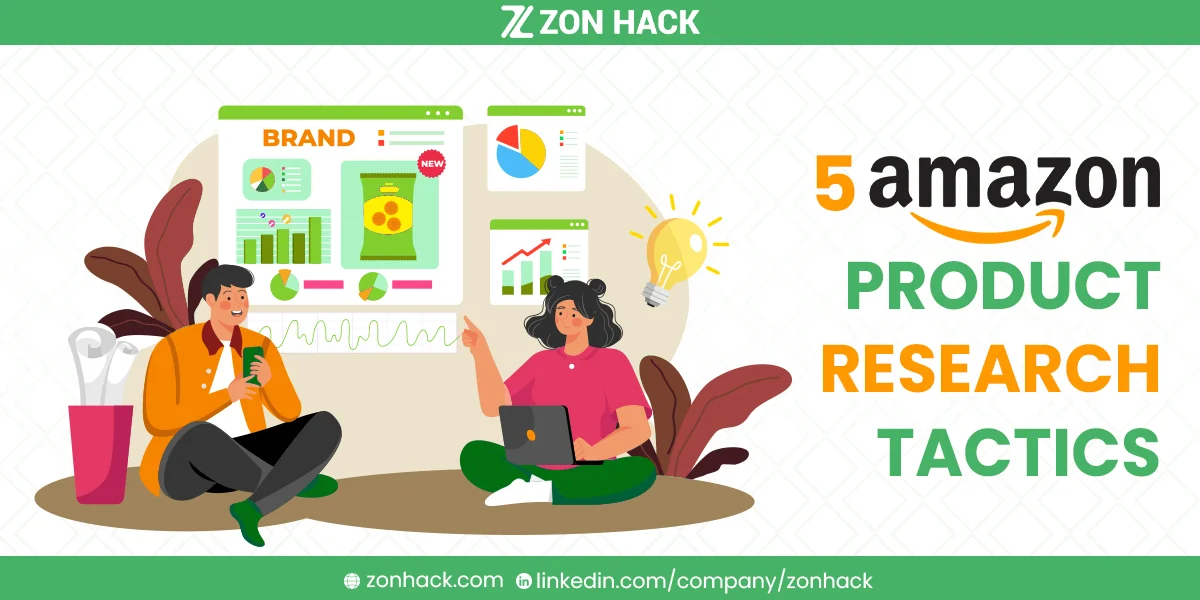To start any business and make headway involves considering pertinent variables, including forecasting, planning, analyzing, budgeting, and examining the ins and outs. The same processes are involved in the case of selling on Amazon and Amazon FBA. However, the cogent part is finding the actual product to sell and doing in-depth research to know if the product will perform well or otherwise. Whether you see selling on Amazon as a side-gig or not, the place of planning and research can’t be overemphasized because you don’t want to blindly invest in a product that will capsize.
This research guide for Amazon is written for you to give you insights into the most effective Amazon product research tactics you need.
What is Amazon Product Research?
As a beginner, it is not entirely easy to build a business on Amazon. Even though it is an effortless process to set up a seller’s account, you can even start off without any inventory by just selling a few items you no longer need (like old books). However, regardless, the essence of product research cannot be undermined.
Amazon product research is the process of analyzing ongoing trends and data available from the marketplace to select a niche with top-demand products that will generate huge sales. The goal is to purchase your products at the lowest possible price and then sell the products with the highest profit ratio possible.
Product research is an integral part of private labeling (the method of selling products that you produce and distribute under your own brand). Over the years, private label selling has become the most widely used method of selling on Amazon because it has proven to be effective against all odds, while product research has become a complicated process that involves series of steps.
Good Products vs. Bad Products
What makes a product bad isn’t because the product itself is bad, but because you didn’t carry out your due diligence and research before investing in such products. If you want good products, you need to solely research products that sell, not the ones that will take forever before you can sell them.
You also need to consider the product from the point of view of a seller that you are. For instance, you might discover that 50-inch TVs are selling at a speed of light, but from a practical point of view, as an Amazon seller most likely working from home, you’ll have trouble not only with storage of stock but also shipping fees, not to mention brand restrictions.
So, you need to focus and concentrate on products that make running your eCommerce business simple.
Good Products fit the following criteria:
- Small, lightweight, robust – easy to store pack and post.
- A price point of between £10 and £50 – attracting impulse buys.
- Unbranded (with branding potential) – higher margins available.
- Low competition – a chance to enter the market.
If you keep these criteria at the back of your mind, you will filter out items that don’t meet these requirements, and hence, your research work becomes more specific and less daunting. You no longer need to consider heavy or bulky products, branded products, perishable products that don’t fall into the stated criteria.
Now that your research is more specific, you need to know Amazon research tactics to find the perfect profitable product, a simple process.
Top Amazon Research Tactics for Sellers
Research is the gateway to finding winning products to sell on Amazon. So, you must make sure you do it right and know exactly where and how to carry out your research. Below are the expert-proven tactics to conduct the most effective Amazon product research in 2021.
1. Amazon Lists
If you should head anywhere for your research, it should firstly be Amazon itself. More specifically, the Amazon Bestseller lists, which not only include ‘bestsellers,’ but also include ‘movers and shakers,” ‘most wished for’ and ‘gift ideas’ sections. All of these can offer invaluable insights into the type of products you should be considering for your inventory.
Go to the Amazon Bestsellers page and start your research.
Use Bestsellers to check the top 100 bestselling products in any category. A smart move will be to dig deeper into the sub-categories. Don’t just peruse the leading seller in the top-level category and select the products you will source and sell based on that.
Instead, it will be smart to select a sub-category and check through the top 100 there. Though it may still be popular, there will be less competition, and you can easily spot your ideal product. Moving on, select a product you want to further research and search for a similar but better version than the initial product.
- Use Hot New Releases to discover the products making massive sales and the products about to be released. Like the Bestsellers, you need to narrow your search and base it on products similar to the newly released products. If you are swift with your research, you can source a popular product before its release date; this is to your advantage as you will cash in immediately.
- Use Movers and Shakers to discover the products that have gained an increase or decrease in popularity over the last 24 hours. This is an excellent tactic if you have a product you want to monitor for a period before adding it to your inventory. Be smart with your monitoring, as you may miss a golden opportunity if taken for granted.
- Use Most Wished For and Most Gifted to view the products that are often added to the gift lists or ordered as gifts. This will help you see the trending products, hence, feeding you with ideas for further niche research.
2. Speak with Your Current Supplier
Another excellent tactic is speaking with your current supplier. You can get the unofficial low down on their best-selling products and know the hottest and trending products. Your supplier is deemed to be well versed so you can get up-to-date information from him. Note that the more the product you purchase from one source, the lower the unit cost, and by doing this, you can achieve huge discounts ad get the latest product ideas.
3. Spy on Your Competitors
Another amazing Amazon product research tactic is to check successful products through Amazon PPC. Doing this will give you insights into how these sellers were able to attain such feats.
4. Utilize Google Trends
Google Trends is one of the best tools you can use for your Amazon product research. You just need to set up alerts so you can instantly receive notifications about trending and popular topics.
Although you are not directly notified of ‘products’ per se, you can identify and discern relevant topics around your product needs. This allows you to explore potential products that you can sell on Amazon.
Alternatively, you can search on Google Trends itself. Simply choose the UK, search for a product and choose web search to see results returned for all related products.
5. Look at eBay’s Trending Lists
eBay is an ideal place to spot in-demand products that you can source and sell on Amazon. It is an amazing place to source information for product research because if an item is making a massive sale on eBay, it is likely to make huge sales on Amazon.
Visit eBay’s trending list page, and you’ll be able to view all trending products across a choice of categories. Note that not all products will fit your research criteria.
6. Browse through AliExpress and Find the Bestsellers
This is often overlooked, even though it is a fantastic Amazon product research tactic. AliExpress is one of the biggest trade marketplaces that you have free access. Don’t just use it for product sourcing but for research as well.
AliExpress doesn’t have a dedicated page for bestselling products, but you can still search which products are popular in three easy steps:
- Choose a category or sub-category, e.g., pet supplies
- Sort results by ‘orders’ to see the highest sold numbers first
- Filter the results to display products with a 4* rating
You’ll now see all the top-selling products in your chosen category or sub-category, and you can rest assured as it will come with 4 stars and above ratings from previous buyers.
How to Come Up with Product Ideas on Amazon
If you know the product you want to sell, it is easy to verify such a product’s demand with a research tool. However, the situation is different when you have no clue of the direction to follow. Below are some valuable tips that will help you map out countless product opportunities:
Tip 1 – 999 Method
This is a tactic that comes in handy in the later stages of selection. It can simply help you to identify your competitor and, among their listings, find the product that you plan to sell.
There are few steps to follow:
- Identify your competitors and, among their listings, find the product that you plan to sell.
- Add the product to the shopping cart.
- In the cart, change the quantity to “10+” and then to 999.
- Then you might see a message like, “Only 149 items are available from that seller.”
- Remember this number and repeat the process after a week or so.
This way, you can check how many items were sold within a period. This can give you a general idea about what you should look into when selling the product yourself.
You have to do this with every competitor to get an exact result. Unfortunately, this will not work for any item or any competitor because some sellers set up a maximum number of products that you can add to the cart.
Tip 2 – Keep an Eye on BSR Changes
You should keep an eye on products whose number of sales has skyrocketed recently. You can improve sellers’ ideas by checking the products whose BSR (Bestselling Rating) has boomed in the last 24 hours. Further steps will help you determine what you can do to make your listing better.
Tip 3 – Check New Arrivals and Trending Products
Check out for the hottest and latest products to outline cogent purchase patterns and customer needs. With this, you can know the product that is popular or currently being sold. You can also use it to outline gaps you need to fill with your bestselling propositions.
Tip 4 – Get to Know the Most Wished Products
When you know the most wished-for products by your potential buyers, you will have insights into what’s important to people and what they are ready and willing to pay for. Your priority will then be to purchase products that will fulfill these wishes.
Tip 5 – Check What People Search for
It is also imperative that you check and analyze the most frequent search queries by potential customers. This generated information will serve as a lead to identify your business’s most promising trading directions.
Check keyword search volume and their monthly usage to know the user’s interest, product seasonality, average price, and competition level.
Tip 6 – Keep in Mind Customer Needs
When you cater to the buyers’ needs, you can easily rise to the top-selling positions with your products.
Ask yourself the following questions to understand if there is a demand for this product:
- What is this Amazon product for? Can a user quickly find information about it?
- What makes your product stand out from the crowd, and is it evident to buyers?
- How do similar products perform on the market? What customer reviews and ratings do they have?
- Are there any gaps in similar products that you can use for your benefit?
- Is there any product (accessory) to be used together or complement the already sold item?
Final Thoughts
Your Amazon product research will become easy and effective when you follow the tactics outlined in this article. Also, remember to ‘niche down your research whilst using competitors’ information and trends. There’s no point in trying to sniff out products that are non-starters when you can easily narrow down your research and recognize a bestselling product using the above detailed Amazon research tactics.




